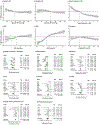Factors Associated With Circulating Sex Hormones in Men : Individual Participant Data Meta-analyses
- PMID: 37639720
- PMCID: PMC10995451
- DOI: 10.7326/M23-0342
Factors Associated With Circulating Sex Hormones in Men : Individual Participant Data Meta-analyses
Abstract
Background: Various factors modulate circulating testosterone in men, affecting interpretation of testosterone measurements.
Purpose: To clarify factors associated with variations in sex hormone concentrations.
Data sources: Systematic literature searches (to July 2019).
Study selection: Prospective cohort studies of community-dwelling men with total testosterone measured using mass spectrometry.
Data extraction: Individual participant data (IPD) (9 studies; n = 21 074) and aggregate data (2 studies; n = 4075). Sociodemographic, lifestyle, and health factors and concentrations of total testosterone, sex hormone-binding globulin (SHBG), luteinizing hormone (LH), dihydrotestosterone, and estradiol were extracted.
Data synthesis: Two-stage random-effects IPD meta-analyses found a nonlinear association of testosterone with age, with negligible change among men aged 17 to 70 years (change per SD increase about the midpoint, -0.27 nmol/L [-7.8 ng/dL] [CI, -0.71 to 0.18 nmol/L {-20.5 to 5.2 ng/dL}]) and decreasing testosterone levels with age for men older than 70 years (-1.55 nmol/L [-44.7 ng/dL] [CI, -2.05 to -1.06 nmol/L {-59.1 to -30.6 ng/dL}]). Testosterone was inversely associated with body mass index (BMI) (change per SD increase, -2.42 nmol/L [-69.7 ng/dL] [CI, -2.70 to -2.13 nmol/L {-77.8 to -61.4 ng/dL}]). Testosterone concentrations were lower for men who were married (mean difference, -0.57 nmol/L [-16.4 ng/dL] [CI, -0.89 to -0.26 nmol/L {-25.6 to -7.5 ng/dL}]); undertook at most 75 minutes of vigorous physical activity per week (-0.51 nmol/L [-14.7 ng/dL] [CI, -0.90 to -0.13 nmol/L {-25.9 to -3.7 ng/dL}]); were former smokers (-0.34 nmol/L [-9.8 ng/dL] [CI, -0.55 to -0.12 nmol/L {-15.9 to -3.5 ng/dL}]); or had hypertension (-0.53 nmol/L [-15.3 ng/dL] [CI, -0.82 to -0.24 nmol/L {-23.6 to -6.9 ng/dL}]), cardiovascular disease (-0.35 nmol/L [-10.1 ng/dL] [CI, -0.55 to -0.15 nmol/L {-15.9 to -4.3 ng/dL}]), cancer (-1.39 nmol/L [-40.1 ng/dL] [CI, -1.79 to -0.99 nmol/L {-51.6 to -28.5 ng/dL}]), or diabetes (-1.43 nmol/L [-41.2 ng/dL] [CI, -1.65 to -1.22 nmol/L {-47.6 to -35.2 ng/dL}]). Sex hormone-binding globulin was directly associated with age and inversely associated with BMI. Luteinizing hormone was directly associated with age in men older than 70 years.
Limitation: Cross-sectional analysis, heterogeneity between studies and in timing of blood sampling, and imputation for missing data.
Conclusion: Multiple factors are associated with variation in male testosterone, SHBG, and LH concentrations. Reduced testosterone and increased LH concentrations may indicate impaired testicular function after age 70 years. Interpretation of individual testosterone measurements should account particularly for age older than 70 years, obesity, diabetes, and cancer.
Primary funding source: Medical Research Future Fund, Government of Western Australia, and Lawley Pharmaceuticals. (PROSPERO: CRD42019139668).
Conflict of interest statement
Figures



References
-
- Ding EL, Song Y, Malik VS, et al. Sex difference of endogenous sex hormones and risk of type 2 diabetes. JAMA 2006; 295: 1288–99. - PubMed
-
- Marriott RJ, Murray K, Flicker L, et al. Lower serum testosterone concentrations are associated with higher incidence of dementia in men: the UK Biobank prospective cohort study. Alzheimers Dement 2022; 18: 1907–1918. - PubMed
-
- Yeap BB, Marriott RJ, Antonio L, et al. Serum testosterone is inversely, and sex hormone-binding globulin directly, associated with all-cause mortality in men. J Clin Endocrinol Metab 2021; 106: e625–e637. - PubMed
-
- Wittert G, Bracken K, Robledo KP, et al. Testosterone treatment to prevent or revert type 2 diabetes in men enrolled in a lifestyle program (T4DM): a randomised, double-blind, placebo-controlled, 2-year, phase 3b trial. Lancet Diabetes Endocrinol 2021; 9: 32–45. - PubMed
-
- Shi Z, Araujo AB, Martin S, et al. Longitudinal changes in testosterone over five years in community-dwelling men. J Clin Endocrinol Metab 2013; 98: 3289–97. - PubMed
Publication types
MeSH terms
Substances
Grants and funding
LinkOut - more resources
Full Text Sources
Miscellaneous
